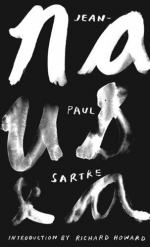|
This section contains 313 words (approx. 1 page at 400 words per page) |

|
The Fictional Diary
Nausea is written in the form of a fictional diary. An "Editors' Note" that opens the novel states that the diary was found among the notebooks of Antoine Roquentin. Since the diary is entirely fictional, as is the character Roquentin, Sartre's inclusion of this "Editors' Note" adds a sense of authenticity to the story. The "diary" also includes several editors' footnotes, which explain certain inconsistencies in the entries. For example, one footnote explains that a word has been crossed out in the handwritten original of Roquentin's diary, while another clarifies a date that was not specified in the original. Like the "Editors' Note," these footnotes create a sense of authenticity, as if Roquentin had been a real person and his original diary were a real document. These elements in the novel contribute to the story's sense of realism.
First-Person Narrative
As a fictional diary, Nausea is...
|
This section contains 313 words (approx. 1 page at 400 words per page) |

|




